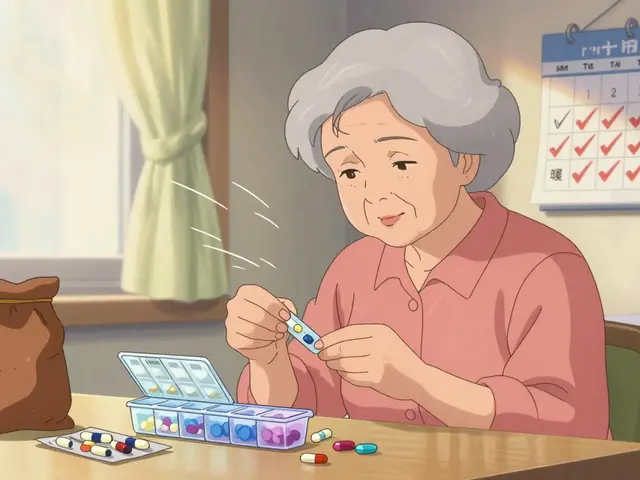Spotting lupus before it spreads can change a patient’s whole trajectory. early diagnosis lupus means catching the disease when a simple skin patch or a mild ache is the only warning sign, rather than waiting for kidneys or the heart to protest.Discoid Lupus Erythematosus is a chronic form of cutaneous lupus that primarily affects the skin, producing round, scaly lesions that can scar if left untreated. Systemic Lupus Erythematosus is a multisystem autoimmune disease that can involve skin, joints, kidneys, brain, and blood vessels, often presenting with a wide range of symptoms. Both share a genetic backdrop and immune‑driven inflammation, but the stakes differ dramatically when the disease erupts beyond the skin.
Key Takeaways
- Early detection of DLE and SLE reduces organ damage and improves quality of life.
- Skin changes, joint pain, and fatigue are often the first clues.
- Blood tests (ANA, anti‑dsDNA, complement) and skin biopsy confirm the diagnosis.
- Treatment started within months can prevent permanent scarring in DLE and kidney failure in SLE.
- Regular monitoring by a rheumatologist is essential even after symptoms improve.
Understanding Discoid and Systemic Lupus
Discoid Lupus Erythematosus (DLE) usually appears as circular, red‑purple patches on the face, scalp, or ears. The lesions are thick, adherent, and may cause permanent scars or hair loss if ignored. While DLE is confined to the skin for most patients, about 10‑15 % eventually develop systemic features.
Systemic Lupus Erythematosus (SLE) is the more aggressive sibling. It can affect kidneys (lupus nephritis), brain (cognitive fog, seizures), heart (pericarditis), lungs, and blood cells. The classic “butterfly” rash on the cheeks is just one of many possible skin manifestations, and many patients first notice joint pain or unexplained fatigue.
Why Timing Matters
Inflammation is the engine that drives lupus. The longer it runs unchecked, the more it remodels tissues, deposits immune complexes, and triggers irreversible damage. Early intervention can:
- Stop skin lesions before they scar (DLE).
- Prevent lupus nephritis from reaching a stage requiring dialysis.
- Reduce the risk of cardiovascular events, which are three times higher in untreated SLE.
- Allow patients to stay on lower‑dose medications, minimizing side‑effects like osteoporosis or cataracts.
Red‑Flag Symptoms to Spot Fast
Both forms share some early signals, but each also has unique tell‑tale signs.
Common early clues
- Persistent fatigue that doesn’t improve with rest.
- Joint stiffness or swelling, especially in the hands.
- Unexplained fever or night sweats.
- Sensitivity to sunlight (photosensitivity).
Discoid‑specific cues
- Round, coin‑shaped plaques with a raised, scaly border.
- Lesions that heal with atrophic scarring or pigment changes.
- Scalp involvement leading to patchy hair loss.
Systemic‑specific cues
- Swollen knees or elbows without clear injury.
- Blood in urine (proteinuria) or unexplained swelling of the ankles.
- Persistent mouth ulcers or chest pain that worsens when breathing.

Diagnostic Toolbox
Clinicians blend clinical observation with laboratory data to confirm lupus. The goal is to rule out mimic conditions (psoriasis, dermatomyositis, rheumatoid arthritis) and assign the correct subtype.
| Test | What It Shows | Typical Result in DLE | Typical Result in SLE |
|---|---|---|---|
| Antinuclear Antibody (ANA) | Presence of auto‑antibodies against cell nucleus | Positive in ~30‑40 % | Positive in >95 % |
| Anti‑dsDNA | Specific for double‑stranded DNA | Usually negative | Positive in 60‑70 % of active SLE |
| Complement C3/C4 | Markers of immune complex consumption | Typically normal | Low during flares |
| Skin Biopsy | Histology of lesions | Shows interface dermatitis, thickened basement membrane | May show similar changes if cutaneous SLE present |
| Urinalysis | Detects protein, blood, casts | Usually normal | Proteinuria or hematuria indicates nephritis |
When the picture isn’t clear, clinicians may also order imaging (renal ultrasound), electrophysiology for neuropathy, or repeat labs to track trends.
Discoid vs. Systemic Lupus - Side‑by‑Side
| Aspect | Discoid Lupus Erythematosus (DLE) | Systemic Lupus Erythematosus (SLE) |
|---|---|---|
| Primary organ involvement | Skin only (≈85 % of cases) | Multiple organs (skin, kidneys, CNS, joints, heart) |
| Typical age of onset | 20‑40 years | 15‑45 years, peaks at 20‑30 years |
| Autoantibody profile | ANA positive in ~30‑40 %; often no specific antibodies | ANA positive >95 %; anti‑dsDNA, anti‑Sm, antiphospholipid often present |
| Risk of organ damage | Low; mainly scarring skin | High; especially kidneys, CNS, cardiovascular system |
| First‑line treatment | Topical steroids, intralesional triamcinolone, sun protection | Hydroxychloroquine + systemic steroids; add immunosuppressants if severe |
| Long‑term prognosis | Generally good; <5 % evolve to SLE | Variable; 10‑year survival >90 % with modern care, but morbidity high |
Treatment Pathways - Early vs. Late Intervention
When lupus is caught early, doctors can start with the least aggressive drugs, tailoring therapy as the disease evolves.
Early-stage DLE
- High‑potency topical corticosteroids (clobetasol) applied twice daily.
- Intralesional steroids for persistent plaques.
- Strict photoprotection (UVA/UVB sunscreen SPF 50+, hat, clothing).
- Smoking cessation - smoking worsens skin lesions.
Early-stage SLE
- Hydroxychloroquine (200‑400 mg daily) - reduces flares and improves survival.
- Low-dose prednisone (≤7.5 mg) to control inflammation while minimizing side‑effects.
- Regular monitoring of blood counts, kidney function, and complement levels.
- Vaccinations (influenza, pneumococcal) before immunosuppression.
Late-stage disease
If diagnosis is delayed, patients often need stronger immunosuppressants (mycophenolate, cyclophosphamide) or biologics (belimumab, rituximab). These carry higher infection risk and require intensive lab surveillance. Starting with a mild regimen avoids these complications in many cases.
Practical Steps for Patients and Clinicians
For patients:
- Track any new skin changes with photos and dates.
- Note joint pain, fatigue, or urinary changes and bring them to your doctor.
- Ask for ANA testing if you have a persistent rash or unexplained symptoms.
- Never skip sunscreen, even on cloudy days.
- Join a lupus support group - sharing experiences often speeds up recognition.
For clinicians:
- Maintain a low threshold for ordering ANA when skin lesions are atypical.
- Refer any patient with persistent discoid plaques to dermatology for biopsy.
- Use the 2019 EULAR/ACR classification criteria to differentiate DLE‑only from early SLE.
- Implement a treat‑to‑target strategy: aim for disease activity score <5 within 6 months.
- Schedule follow‑up labs every 3-6 months to catch serological changes early.
Common Myths and Pitfalls
- Myth: “If my rash looks like acne, it can’t be lupus.” - Reality: Lupus lesions can mimic acne, especially on the cheeks. Biopsy distinguishes them.
- Myth: “Only women get lupus.” - Reality: Men comprise ~10 % of cases and often present with more severe organ involvement.
- Myth: “A negative ANA rules out lupus.” - Reality: About 5 % of SLE patients are ANA‑negative; clinical judgment matters.
- Myth: “If you feel fine, you can stop medication.” - Reality: Lupus can flare silently; stopping hydroxychloroquine raises flare risk.
Looking Ahead
Research in 2024‑2025 is honing blood‑based gene signatures that could flag lupus months before symptoms appear. While these tests aren’t routine yet, they underscore why clinicians are pushing for earlier screening in high‑risk groups (family history, certain ethnicities).
In practice, the mantra remains simple: suspect, test, treat early, and monitor continuously. Doing so turns a potentially life‑threatening disease into a manageable chronic condition.
What are the first skin signs of discoid lupus?
The earliest lesions are round, red‑purple plaques with a raised, scaly edge. They often appear on the face, scalp, or ears and may heal with atrophic scarring.
Can a negative ANA test rule out systemic lupus?
No. Although >95 % of SLE patients test positive, a small minority are ANA‑negative. Doctors rely on clinical criteria and other antibodies when ANA is negative.
How soon should treatment start after a lupus diagnosis?
Ideally within weeks. Starting hydroxychloroquine and low‑dose steroids early can prevent organ damage and improve long‑term survival.
Is sunscreen really necessary for lupus patients?
Absolutely. UV exposure can trigger or worsen both DLE and SLE flares. Broad‑spectrum SPF 50+ applied every 2 hours is the standard recommendation.
What lifestyle changes help manage lupus?
Avoid smoking, maintain a balanced diet rich in omega‑3s, exercise regularly (low impact), get adequate sleep, and manage stress through mindfulness or therapy.








They don't want you to know that catching lupus early is basically a secret weapon of the shadowy health elite, designed to keep us dependent on endless drug cycles.
Every time a dermatologist spots a tiny discoid patch, a hidden network of pharma executives smiles, counting the future prescriptions.
But if we peer through the veil and demand immediate testing, the whole system trembles.
Wake up, people – early diagnosis is the first act of rebellion.
Indeed, the moral imperative is unmistakable; we must champion vigilance, not complacency.
It is ethically indefensible to allow the subtle harbingers of systemic lupus to fester unnoticed, for the sake of convenience, or profit.
Early detection safeguards not only individual health, but also upholds the societal contract that dictates care for the vulnerable.
One cannot, in good conscience, dismiss the flood of scientific evidence that underscores the lifesaving potential of prompt intervention.
Therefore, we must demand standardized screening protocols with unwavering resolve.
Look, catching lupus before it escalates is a game‑changer, and you’ve got the power to make that happen for yourself or a loved one.
Stay on top of those skin changes, fatigue, and joint aches – they’re the early warning lights.
When you push for those labs early, you’re not just preventing organ damage, you’re buying years of quality life.
Keep that momentum, and you’ll see the difference.
When we consider the phenomenon of lupus through the lens of cultural narrative, we discover that illness is not merely a biological malfunction but a story our bodies tell about discord in the larger system.
Early diagnosis, then, becomes an act of listening, an invitation to reinterpret that story before it spirals into tragedy.
It is as if the immune system, once a guardian, has begun to recite a tragic poem, and the physician must intervene to rewrite the verses.
By identifying discoid lesions or subtle serological markers, we halt the progression of that poem at its refrain.
This intervention respects the principle that every individual deserves a chance to author their own health destiny rather than be conscripted by an unseen script.
Moreover, the psychological relief that accompanies a clear diagnosis cannot be overstated; uncertainty is a heavy burden that weighs on both mind and body.
Patients who learn of their condition early can adopt lifestyle changes, engage with support groups, and align treatment with personal values, fostering agency.
From a public health perspective, early detection mitigates long‑term costs, preserving resources for broader societal needs.
These savings translate into fewer hospitalizations, less reliance on aggressive immunosuppressants, and ultimately, a healthier community.
In the grand tapestry of medicine, lupus serves as a reminder that timing is not just a clinical variable but a moral one.
We owe it to individuals to deploy the diagnostic tools at our disposal without hesitation.
The 2019 EULAR/ACR criteria, for instance, provide a roadmap that, when followed promptly, can differentiate isolated cutaneous disease from nascent systemic involvement.
Such precision prevents overtreatment of skin‑only disease while ensuring systemic cases receive the necessary vigilance.
It also respects the patient's autonomy, allowing them to make informed choices about their therapeutic journey.
Thus, early diagnosis is a convergence of science, ethics, and humanity, each reinforcing the other.
In the end, it is an affirmation that we choose to listen, to act, and to heal before the storm fully arrives.
Thank you for that thorough exposition; it elegantly captures both the clinical and humanistic dimensions of early lupus detection.
In practice, we encourage patients to document skin changes with photographs, maintain symptom journals, and engage with community support networks 🌟.
Such collaborative approaches foster empowerment and promote adherence to monitoring protocols.
By integrating rigorous diagnostics with compassionate care, we advance outcomes for diverse populations.
Oh sure, because the pharmas love nothing more than letting us catch lupus early – they’re just itching to hand us free vaccines and miracle creams 🙄.
In reality, the “early diagnosis” push is just another way to keep us hooked on endless follow‑up appointments and lab draws.
Wake up, folks, the system thrives on chronic care, not cures.
Let’s cut through the noise and focus on facts: early detection actually reduces the need for aggressive treatments later on, which benefits everyone.
By sharing data, supporting patient education, and streamlining referrals, we can cut down on unnecessary medical waste.
That’s a win‑win for patients and the healthcare system alike.
The stakes are nothing short of epic – imagine a world where a simple skin biopsy saves a kidney from irreversible damage.
That vision fuels our collective drive to act swiftly, to marshal resources, and to champion proactive screening.
When clinicians heed those early skin clues, they become guardians against a cascade of organ failure.
Every timely intervention writes a new chapter of hope in the lupus saga.
yeah sure, early lupus detection totally isn't just a fancy word for "more paperwork for doctors."
Do not diminish the gravity of preemptive diagnostics with such flippant sarcasm; the very act of recognizing lupus at its inception is a triumph of modern medicine over chaos.
To trivialize it is to betray the countless patients whose lives hinge on those pivotal early lab results.
The gravity of this battle cannot be overstated.
Totally get it – early checks really do make a huge diff for folks dealing with lupus
stay supportive and keep spreading the word